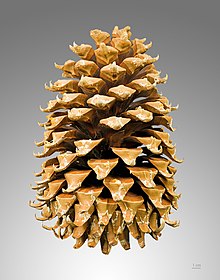Coulter pine
| Coulter pine | ||||||||||||
|---|---|---|---|---|---|---|---|---|---|---|---|---|

Coulter pine ( Pinus coulteri ) with cones. |
||||||||||||
| Systematics | ||||||||||||
|
||||||||||||
| Scientific name | ||||||||||||
| Pinus coulteri | ||||||||||||
| D. Don |
The Coulter pine ( Pinus coulteri ) is a plant from the genus of pine trees in the family of Pinaceae (Pinaceae).
distribution
The Coulter Pine is native to southwest California and the extreme north of Mexico in lower, dry locations. It is not very hardy in Central Europe ; in Germany it only grows with a few specimens in the warmest regions, such as the Rhine Valley.
description
The Coulter pine grows as an evergreen tree that can reach heights of up to 28 meters and trunk diameters of around 1 meter. Its bark is black to gray-brown with a slight purple tint; it forms thick ridges or large plates with wide, deep cracks between them. Young trees have a light gray, also clearly cracked bark.
The treetop grows wide. The crown of young trees is loose with only a few branches pointing upwards at the ends. Older trees have long, slightly drooping branches.
The branches are very thick and furrowed. The bark of young twigs is bluish to bluish white, later reddish brown. The long inner part of the branch is not needled and shows only narrow brown scales. The buds are bright orange, thick, pointed and up to 5 inches long. The blue-green needles stand in clusters of three and are very thick and stiff; they become 25 to 30 centimeters long.
The male cones form 6 to 12 centimeters in length on the lower part of the new branches; they are thickly egg-shaped, purple-pink (yellowish during the dusting around the beginning of June) and about 2 centimeters long. The cones grow in the uppermost crown tip; they are massive, long ovoid and the heaviest of all pine species: the cones are 20 to 35 centimeters long and weigh up to 2 kg, sometimes even up to 3 kg. The base of the tenon is crooked; the scales are light brown; their thick ends end in very sharp pin hooks of up to 2 cm in length, which are protruding and bent upwards; only a few base scales are bent downwards in a different way.
Differentiation from similar species
The Jeffrey pine has much smaller cones that have much shorter thorns on the scales. Pinus sabiniana has similar cones, but they are also smaller, and the spines of the scales are all curved downwards.
Systematics and taxonomy
Pinus coulteri was first described in 1836 by David Don in Transactions of the Linnean Society of London, Volume 17, Page 440. Synonyms are Pinus macrocarpa Lindl. and Pinus ponderosa subsp. coulteri (D.Don) AEMurray . The species was discovered by Dr. Coulter.
Others
Because of the huge cones, the Coulter pine is also called big-cone pine in California or widow maker (“ widow maker ”).
swell
Individual evidence
- ↑ Rafaël Govaerts (ed.): Pinus. In: World Checklist of Selected Plant Families (WCSP) - The Board of Trustees of the Royal Botanic Gardens, Kew . Retrieved April 18, 2019.
Web links
- Pinus coulteri in the endangered Red List species the IUCN 2006. Posted by: Conifer Specialist Group, 1998. Retrieved on 12 May, 2006.

